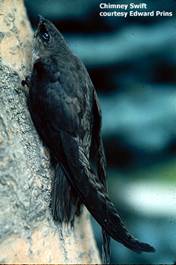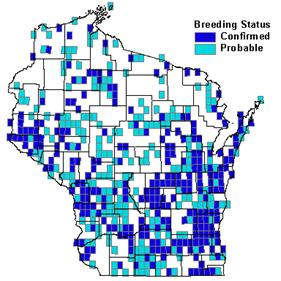

Status/Protection
- Global Rank: G5 Key to global and state ranks
- State Rank: S5B
- WBCI Priority: PIF
Population Information
The Federal BBS information can be obtained at http://www.mbr-pwrc.usgs.gov/bbs/bbs.html by clicking on Trend Estimates and selecting the species in question. All estimates are for time period (1966-2005).
*Note: There are important deficiencies with these data. These results may be compromised by small sample size, low relative abundance on survey route, imprecise trends, and/or missing data. Caution should be used when evaluating this trend.
- Federal Breeding Bird Survey: significant decline
- Federal Breeding Bird Survey (WI): non-significant decline
- Federal Breeding Bird Survey (BCR 23): significant decline
- Federal Breeding Bird Survey (BCR 12): significant decline*
- WSO Checklist Project: significant decline (1983-2007)
Life History
- Breeding Range: Eastern Saskatchewan south to Texas east to the Atlantic Coast (Cink and Collins 2002).
- Breeding Habitat: Northern Hardwood, Hemlock Hardwood; also commonly found in urban areas of all sizes (Cink and Collins 2002).
- Nest: Half saucer attached to a chimney wall or other suitable man-made structure (Ehrlich et al.1988); rarely in tree cavity (Cink and Collins 2002).
- Nesting Dates: Eggs: early May to mid-July (Robbins 1991).
- Foraging: Aerial forage (Ehrlich et al. 1988).
- Migrant Status: Neotropical migrant.
- Habitat use during Migration: A variety of habitats including forests, open areas, urban areas, and open ocean. Urban roost chimneys are important for this species during migration (Cink and Collins 2002).
- Arrival Dates: Mid-April to mid-May (Robbins 1991).
- Departure Dates: Early August to early October (Robbins 1991).
- Winter Range: Central and northeastern South America, including the upper Amazon basin of Peru, Ecuador, Chile, and Brazil (Cink and Collins 2002, Perrins and Elphick 2003).
- Winter Habitat: Not well-known but known to roost in chimneys, churches, and caves. Forages over open terrain (Cink and Collins 2002).
Habitat Selection
Historically, the Chimney Swift nested in large hollow trees, tree cavities, and caves, but the loss or alteration of these natural sites has caused this species to adapt to man-made structures (Kyle and Kyle 2004). Modern structures such as chimneys, water cisterns, silos, outbuildings, latrines, barns, signs, sign posts, and garages provide the darkness and security from the elements required by nesting and roosting swifts. Tree cavities and hollow snags are still used as nest sites wherever available (Damro 2003), but the majority of nesting now occurs in urban areas (Cink and Collins 2002). Cavity dimensions generally are larger than those of other cavity nesters because of the swift’s propensity to fly within the nest cavity (Damro 2003). Cavity diameter is generally >25 cm with a depth ranging from 1-16 m. Foraging also occurs in urban areas as well as a wide range of other open habitats (Cink and Collins 2002).
Habitat Availability
The Chimney Swift nests uniformly throughout the state, especially in the more urban south and central regions (Robbins 1991, Carpenter 2006). With the exception of natural tree cavities (Damro 2003), Chimney Swift nest sites are relatively abundant in Wisconsin. However, changing construction practices are undoubtedly reducing the availability of potential nest sites. New developments often promote plastic, metal, or composite exhaust shafts that are unsuitable as nest sites. Furthermore, historical nest sites are being eliminated as old buildings and factories are demolished (Cink and Collins 2002, Kyle and Kyle 2004).
Population Concerns
The Chimney Swift is one of few species to benefit from human settlement. Its ability to adapt to urban settings and manmade structures facilitated a range expansion in the early twentieth century and a substantial population increase (Cink and Collins 2002, Kyle and Kyle 2004). Today, however, human actions may be contributing to the range-wide declines of this species (Sauer et al. 2005). Although it appears to still be a common breeding species within Wisconsin (Carpenter 2006), there are several factors that threaten its status in the state. Aerial spraying of insecticides reduces prey resources and may impact populations. Modern construction practices and homeowner modifications may be reducing the number of chimneys and other man-made structures available for nesting. Chimney sweeps and exterminators also contribute to nest loss and direct mortalities of adults (Cink and Collins 2002).
Recommended Management
There are several actions that homeowners can take to further Chimney Swift conservation efforts. For homes with existing fireplace chimneys, homeowners should schedule annual cleanings to remove creosote buildup, which prevents the adherence of nests. Cleanings should occur at the termination of winter use but prior to the Chimney Swift nesting season – mid-March is ideal. Masonry chimneys should not be capped to allow for Chimney Swift access; however, metal chimneys are unsuitable for Chimney Swift use and should always be capped to prevent their injury or death. If chimney capping is unavoidable because of insurance or safety reasons, consider removing the cap in the spring prior to the swifts’ arrival and replacing it in the fall or using caps with opening on the sides.
For chimneys with active nests, homeowners are advised to close dampers and fire doors for the duration of the nesting period. This will not only diminish the noise of begging chicks, but also prevent hatchlings from falling into the fireplace or flying into the house. For chimneys lacking an operable damper, a large piece of foam rubber wedged into the lower part of the flue will help lower noise levels. Homebuilders should be encouraged to use swift-friendly chimney materials in new constructions or restoration projects, which include stone, firebrick, or masonry flue tiles with mortared joints. Alternately, homeowners might consider constructing nesting towers to attract swifts to their property (see Information Sources; Kyle and Kyle 2004).
More effort is needed to educate professional chimney cleaners on the conservation of Chimney Swifts. Destroying nests is unnecessary, illegal, and easily preventable with some simple outreach efforts. Suggestions for professional cleaners who encounter nests during a service call include: (1) provide informational handouts to homeowners on the Chimney Swift nesting cycle; (2) close damper or otherwise seal bottom of the flue to minimize begging noises; (3) reschedule cleaning for a later date - >6 weeks for nests with eggs, >4 weeks for nests with young; and (4) at actual cleaning, schedule another cleaning for following spring prior to the swifts’ arrival (Kyle and Kyle 2004). Finally, the proper use and regulation of pesticides in North and South America is important for this and other insectivorous species (Cink and Collins 2002).
Research Needs
Much information is lacking on this species’ breeding biology, including patterns of dispersal from natal sites, survivorship of first-year birds, and records of lifetime reproductive success (Cink and Collins 2002). More research is needed to identify population limiting factors, including the role of nest site availability. An assessment of the location and abundance of important nest sites and migratory roost sites is paramount to future conservation efforts (Kyle and Kyle 2004). Also, winter distribution warrants more study and habitat requirements within these areas (Cink and Collins 2002).
Information Sources
- Chequamegon National Forest Bird Survey (NRRI) species account: http://www.nrri.umn.edu/mnbirds/accounts/CHSWa2.htm
- Chimney Swift Towers: http://www.chimneyswifts.org/page15.html
- Cornell Lab of Ornithology species account: http://www.birds.cornell.edu/AllAboutBirds/BirdGuide/Chimney_Swift.html
- Driftwood Wildlife Association Chimney Swift web page: http://www.chimneyswifts.org/
- Ken Damro, Independent researcher, Traditional Nesters Project, PO Box 543 Florence, WI 54121 traditionalnesters@yahoo.com
- North American Breeding Bird Survey: http://www.mbr-pwrc.usgs.gov/bbs/bbs.html
- Wisconsin Breeding Bird Atlas http://www.uwgb.edu/birds/wbba/
References
- Carpenter, A. 2006. Chimney Swift. In Atlas of the Breeding Birds of Wisconsin. (N.J. Cutright, B.R. Harriman, and R.W. Howe, eds.). The Wisconsin Society for Ornithology, Inc. 602pp.
- Cink,C.L. and C.T. Collins. 2002. Chimney Swift (Chaetura pelagica). In The Birds of North America, No 646 (A. Poole and F. Gill, eds.). The Birds of North America, Inc., Philadelphia, PA.
- Damro, K.F. 2003. News from International habitat Conservation Partnerships. Birdscapes Magazine, Spring/Summer. U.S. Fish and Wildlife Service, Division of Bird Habitat Conservation.
- Ehrlich, P.R., D.S. Dobkin, and D. Wheye. 1988. The birders handbook: a field guide to the natural history of North American birds. Simon and Schuster Inc., New York.
- Kyle, P. and Kyle, G. 2004. Rehabilitation and conservation of Chimney Swifts. Driftwood Wildlife Association. www.chimneyswifts.org (13 June 2007)
- Perrins, C.M. and J. Elphick. 2003. The complete encyclopedia of birds and bird migration. Chartwell Books, Book Sales Inc., New Jersey.
- Robbins, S. D. 1991. Wisconsin birdlife: population & distribution, past & present. Univ. of Wisconsin Press, Madison, WI.
- Rolley, R. 2005. Wisconsin Checklist Project. http://dnr.wi.gov/org/land/wildlife/harvest/reports/07checklist.pdf (13 June 2007)
- Sauer, J.R., J.E. Hines, and J. Fallon. 2005. The North American Breeding Bird Survey, Results and Analysis 1966 - 2005. Version 6.2.2006. USGS Patuxent Wildlife Research Center, Laurel, MD.
Contact Information
- Compiler: Ken Damro, kendamro@yahoo.com
- Editor: Kim Kreitinger, K.Kreitinger@gmail.com
